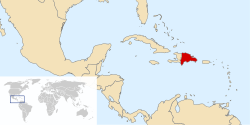Republic of Spanish Haiti
| Republic of Spanish Haiti | ||||||||||
| República del Haití Español | ||||||||||
|
||||||||||
| Capital | Santo Domingo | |||||||||
| Languages | Spanish | |||||||||
| Demonym | Dominican | |||||||||
| Government | Republic | |||||||||
| President | ||||||||||
| • | 1821–1822 | José Núñez de Cáceres | ||||||||
| History | ||||||||||
| • | Independence | December 1, 1821 | ||||||||
| • | Haitian occupation | February 9, 1822 | ||||||||
| Area | 48,442 km² (18,704 sq mi) | |||||||||
| Currency | Santo Domingo real | |||||||||
|
||||||||||
The Republic of Spanish Haiti (Spanish: República del Haití Español) was the independent state that resulted from the defeat of Spanish colonialists from Santo Domingo on November 9, 1821, led by General José Núñez de Cáceres.
On December 1, 1821, a constitutive act was ordered to petition the union of Spanish Haiti with Gran Colombia. The state of the Republic of Spanish Haiti was not supported by the population of slaves and servants who were wary of the rule of pure whites, and preferred to unite with French Haiti, because of their abolition of slavery.
In late 1821 and early 1822, Haiti sent emissaries to the central and northern Spanish Haiti to promote the accession of the country to Haiti, and the people began to raise the Haitian flag on public buildings and plazas, among them Hincha (present-day Hinche), but also in another large cities like Puerto Plata (13 December 1821), Dajabón (15 December), Santiago (29 December) and La Vega (4 January 1822), whereas other forces which opposed unification with Haiti formally declared independence from Spain on December 1, 1821.
A group of politicians and military officers continued to favor uniting the new nation with Haiti, as various elite families sought for political stability under Haitian president Jean-Pierre Boyer. A large faction based in the northern Cibao region were opposed to the union with Gran Colombia and also sided with Haitian president Boyer. Boyer, on the other hand, sought to protect his country from the possibility of France's or Spain's retaking Spanish Haiti and attacking or even re-conquering Haiti. He sought not only to maintain Haitian independence, but to maintain the freedom of its former slaves, as well as to liberate the remaining slaves in Spanish Haiti. After promising his protection to the government of Núnez de Cáceres, Boyer entered with a force of 12,000 soldiers in February 1822, after most cities and towns proclaimed its annexation to the Republic of Haiti between November 1821 and January 1822, including Puerto Plata (December 13, 1821) and Santiago (December 29, 1821).
...
Wikipedia


